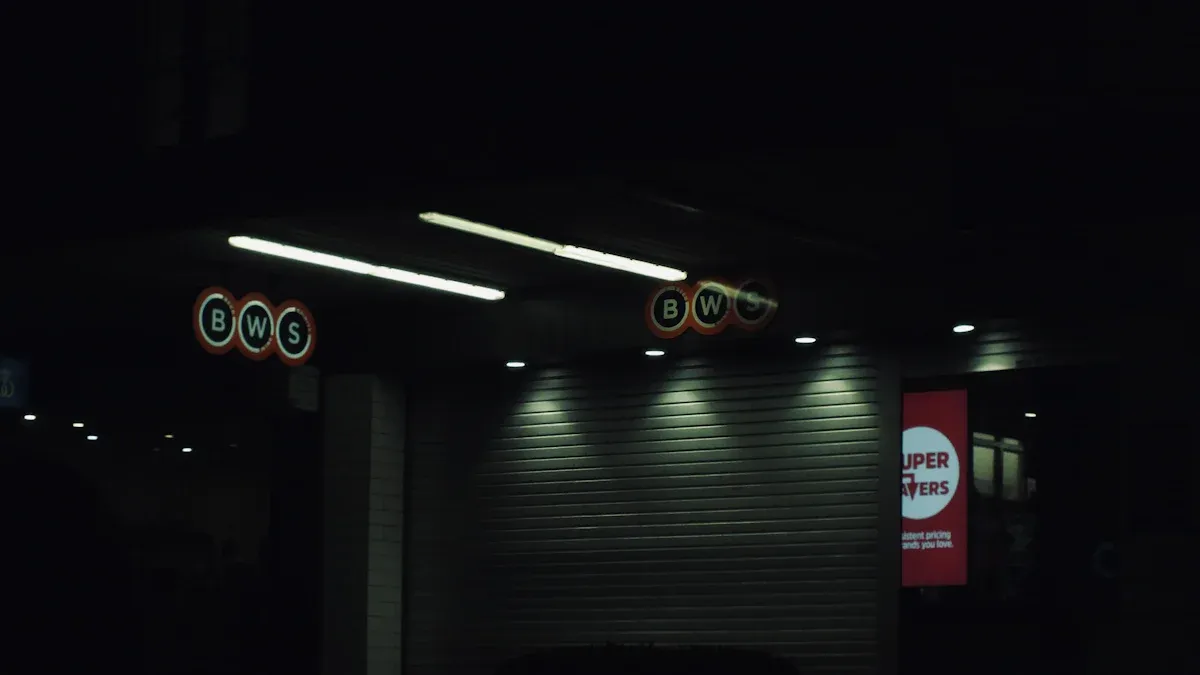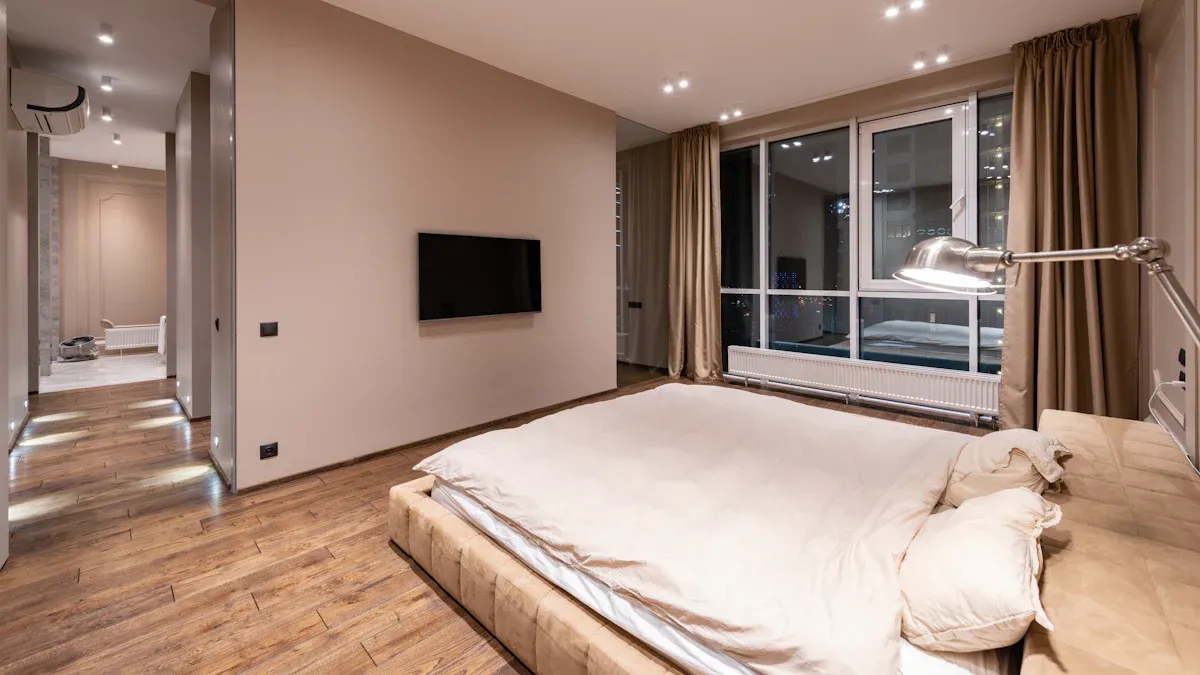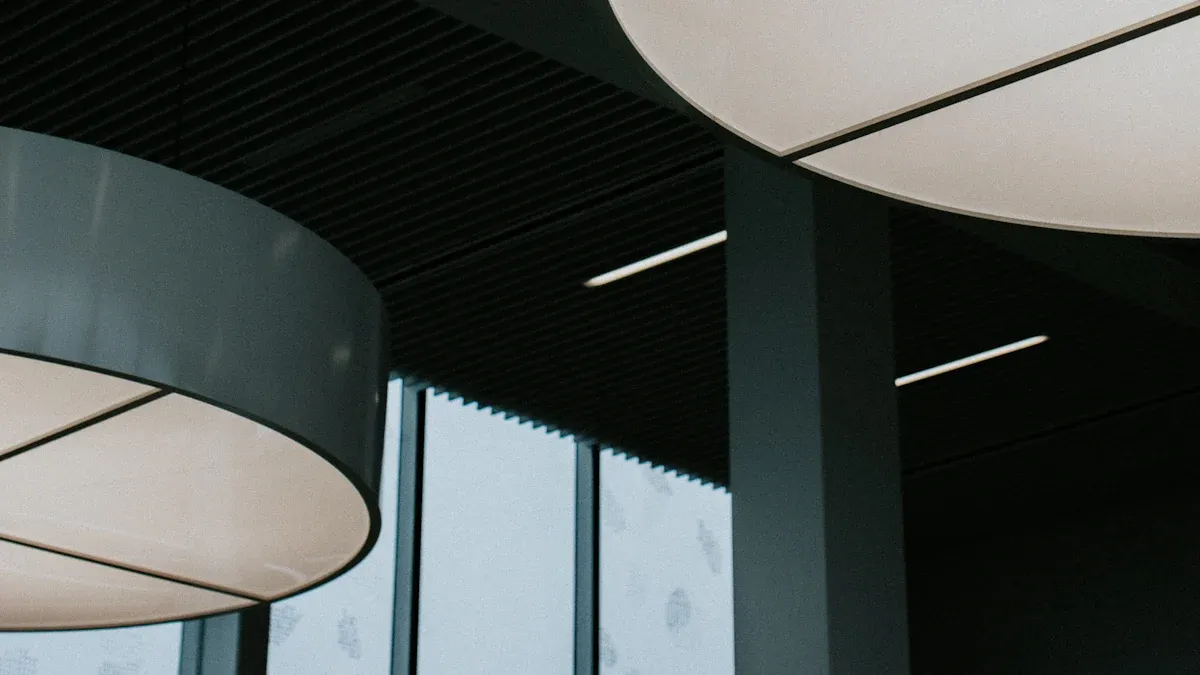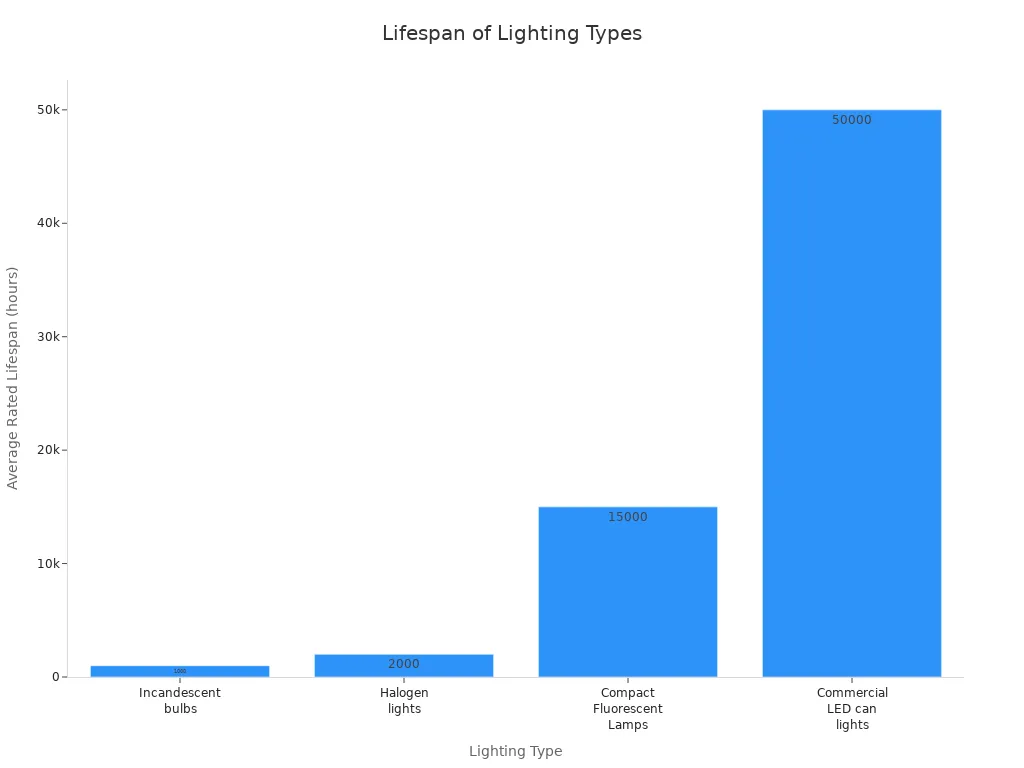Commercial Can Lights focusing on performance, durability, and ROI in 2025

Commercial Can Lights now raise the bar for being reliable and efficient in businesses. Facility managers and business owners want lights that work well and last a long time. The market is changing because LED light technology and smart controls help save energy and protect the planet. Adaptive lighting systems help people work better and feel comfortable. They also help cut down on waste. Picking the right product helps both the building’s value and the environment. This is true for a Home or a big About Us company space.
Key Takeaways
LED commercial can lights use less energy. They last longer and make light better in offices and stores. Strong materials and smart designs help these lights last a long time. This means fewer repairs and less time when lights do not work. Switching to LED can lights saves money in a few years. This is because you spend less on energy and fixing lights. Smart controls and sensors help save even more energy. They also make spaces safer and more comfortable. Picking certified, eco-friendly lights makes buildings worth more. It also helps the planet and meets green goals.
Key Factors
Performance
Commercial can lights work well in many places. Facility managers and business owners want lights that save energy. They often pick LED lighting to use less power and spend less money. LED can lights give bright, focused light. They also have high Color Rendering Index (CRI) values, usually 80 or more. This helps people see colors clearly, which matters in stores and offices. Dimming lets people change how bright the lights are for different jobs. Smart controls like motion sensors and remote controls help save energy. They also make busy areas safer.
Tip: Can lights with focused beams help people work better and feel comfortable in offices, stores, and public places.
Some important things to think about are:
Changing brightness and color
Smart controls for easy use
Even light spread everywhere
Durability
Durability is very important for commercial lighting. Commercial can lights have strong housings that protect inside parts from dust and bumps. New construction models attach right to ceiling joists for strong support. Retrofit models use clamps or metal clips. These are not as strong but still work for many places. LED technology makes less heat, so the lights last longer and break less often.
Facility managers like:
Strong materials and good building methods
LED parts that last a long time (up to 50,000 hours)
Less fixing needed because lights last longer
Note: Durable can lights help stop problems and save money on repairs over time.
ROI
Return on investment (ROI) is a big reason people pick new lights. Upgrading to LED can lights usually pays off in two to three years. This is because they use less energy and need less fixing. Some businesses get their money back even faster with rebates or special programs. The table below shows how long it takes to get your money back:
Scenario | Payback Period (Years) | ROI (%) | Notes on Rebates and Savings |
|---|---|---|---|
Retail Retrofit | ~5.1 - 5.6 | ~18-19.5 | Drops to under 4 years with rebates |
Warehouse Retrofit | Under 3 | ~35-37 | Reduces to ~2.4 years with rebates |
Smart controls like "economize mode" save even more money when fewer people are around. These savings and helping the planet make commercial can lights a good choice for 2025.
Commercial Can Lights Performance

Energy Efficiency
Energy efficiency is very important for facility managers in 2025. Commercial Can Lights now use advanced LED technology. These lights give off a lot of light but use less energy. Many models make over 120 lumens per watt. This makes them much better than old fluorescent or incandescent lights. Facility managers like features such as wireless controls and motion sensors. These tools help turn off lights in empty rooms. Dimming lets people lower the brightness to save more energy. Scheduling features can turn lights on or off at certain times. This matches business hours or daylight. These ideas help businesses save money and help the planet.
Tip: Upgrading to LED-based Commercial Can Lights can cut lighting energy use by up to 85% compared to traditional systems.
Light Quality
Light quality changes how commercial spaces look and work. High color rendering index (CRI) values, often 90 or more, make colors look real and bright. This is important in offices, stores, and factories where seeing colors right helps people do their jobs safely. Lighting with high CRI helps stop eye strain and tired eyes. Workers feel better and can focus longer. Human-centric lighting uses tunable LEDs to change color and brightness during the day. This copies natural daylight and helps people feel happier and pay attention. Using different types of lights together helps people do many tasks and makes spaces feel nice.
Feature | Benefit |
|---|---|
High CRI (90+) | Accurate color, less eye strain |
Tunable LEDs | Adjusts to tasks and time of day |
Dimming | Personalized comfort, energy savings |
Layered Lighting | Supports diverse workplace activities |
Smart Features
Smart features change how Commercial Can Lights work in buildings. IoT lets facility managers control lights from far away and set schedules. Cloud-based analytics show data about energy use and how spaces are used. This helps managers make lighting better for each area. Adaptive lighting uses sensors to see if people are there or if it is bright outside. Lights change by themselves to save energy and make people comfortable. Wireless systems like Bluetooth and Wi-Fi make it easy to set up and add more lights. Predictive maintenance tells managers about problems before they happen. This means less time fixing lights and lower repair costs.
Wireless control lets people manage lights from anywhere.
Motion and daylight sensors change lighting when people come or go.
AI-powered systems learn what people like to make things better.
Connecting with building management systems makes everything work together.
Note: Smart Commercial Can Lights help save energy and make workers feel good by giving the right light at the right time.
Durability

Build Quality
Manufacturers make commercial can lights strong for tough places. They use hard materials like polycarbonate lenses and tough plastic housings. These parts help stop damage from bumps or machines. Many lights have high IK ratings, so they can take hits. Sealed designs keep out dust, water, and chemicals. This helps the lights last longer in places like warehouses and kitchens.
Fixtures often have:
Coatings that stop rust and wear.
Enclosures that keep out water and steam.
Smooth surfaces that are easy to clean.
Lenses that do not turn yellow from sunlight.
Tip: Lights with high IP ratings work well in wet or dirty places.
Manufacturers fix common problems by making wiring better, adding surge protection, and matching fixtures to control systems. The table below shows how they solve these problems:
Common Causes of Failure in Commercial Can Lights | How Manufacturers Address These Issues |
|---|---|
Bad wiring and connections | Use good materials, install right, check often |
Too much power on circuits and fixtures | Check loads when designing and adding lights |
Power surges and voltage changes | Surge protectors, strong power supplies |
Control system problems | Design for system compatibility |
Very hot or cold temperatures | Fixtures made for wide temperature ranges |
Wet or damp places | High IP ratings, anti-rust materials |
Getting hit by things | High IK ratings, strong housings |
Shaking and shocks | Tested for vibration, strong mounts |
Dust and dirt buildup | Smooth, easy-to-clean surfaces, high IP ratings |
Fire or explosion risk | Explosion-proof enclosures |
Picking the wrong fixture | Expert advice, careful planning |
Not enough care or replacement | Preventive maintenance programs |
Lifespan
Commercial can lights with LED technology last much longer than old lights. LEDs work for 50,000 to 100,000 hours. This is two to four times longer than fluorescent or metal halide lights. It is over forty times longer than incandescent bulbs. Longer life means fewer replacements and less fixing. This saves money and time.
LEDs: 50,000 to 100,000 hours
Compact Fluorescent Lamps: Up to 15,000 hours
Halogen lights: About 2,000 hours
Incandescent bulbs: About 1,000 hours

Strong builds and sealed designs help LEDs last their full life, even in hard places. Thermal management lets them work in very hot or cold spots, from -40°F to 149°F. Vapor-tight enclosures keep out water, so there are fewer electrical problems. Many companies give warranties from 3 to 10 years. This shows they trust their product’s durability.
Note: Longer warranties help lower surprise repair costs and make it easier to plan for fixing lights, especially where repairs are hard or cost a lot.
Certifications
Certifications show that commercial can lights meet tough safety and durability rules. The UL Certified mark means a product passed hard tests for fire, shock, and strength. Intertek also checks lights for standards like ANSI/UL 1598 and ANSI/UL 8750. These tests look at heat, shock, and how well lights stay in place. These marks help facility managers trust the lights will be safe and last long.
UL Solutions and Intertek certifications help products meet rules in North America and other places. Some lights have extra ratings, like NSF for food safety or cULus for wet areas. These marks show the lights can handle special places, like kitchens or outside.
Tip: Always look for UL, Intertek, or similar marks when picking commercial can lights. These marks mean the lights passed important safety and durability tests.
ROI
Energy Savings
Businesses that use Commercial Can Lights save a lot of energy. LED technology uses at least 75% less energy than incandescent bulbs. LEDs turn almost all energy into light, not heat. This helps lower electric bills every month. Many companies use smart controls to set when lights turn on or off. These features help save even more energy. For example, a small accounting firm switched from fluorescent lights to LEDs and saved over $2,000 each year. The office kept the same brightness but needed fewer lights and used less power. Most businesses can cut lighting energy use by 25 to 80 percent after upgrading.
LEDs may cost more at first, but they save money over time.
Maintenance Costs
LED Commercial Can Lights cost less to take care of than old lights. LEDs can last up to 30 years, so you do not need to replace them often. They do not use ballasts or strikers, which break in older lights. Fewer repairs mean less time and money spent fixing lights. The table below shows five-year maintenance costs for different lights:
Lighting Type | Maintenance Cost (5 Years) | Replacement Frequency |
|---|---|---|
LED Can Lights | Low | Very Low |
Fluorescent | Medium | High |
CFL | Medium | High |
Incandescent | High | Very High |
Facility managers pick LEDs to avoid lots of repairs and save time.
Property Value
Modern Commercial Can Lights make buildings worth more in many ways:
LED upgrades pay for themselves in 1-3 years with energy savings and rebates.
Maintenance costs go down by 70-90% because LEDs last longer.
Better lighting helps workers get more done, by 5-15%.
Energy-saving LEDs lower bills by 30-50%, so owners make more money.
Rebates and incentives can help owners get money back in the first year.
Property owners see happier tenants and can charge more for rent. Lower costs and better-looking buildings bring in better tenants. All these things help raise the value and image of the property.
Trends 2025
Sustainability
Sustainability is shaping how commercial can lights are made in 2025. Makers now use recyclable things like die-cast aluminum. This helps fixtures last longer and makes less trash. Many companies try to make no waste and do not use harmful stuff like mercury. These steps help the planet during the product’s whole life. LED technology is special because it saves energy and lasts a long time. This means you do not have to replace lights as often, so there is less waste.
Key sustainability trends include:
Smart lighting systems use motion sensors and timers to save energy.
Human-centric lighting changes with your body clock to help people feel good and work better.
Minimalist designs use simple shapes and raw materials for a modern, green look.
Solar-powered lighting is used outside to use less power from the grid.
Dark sky compliant fixtures help stop light pollution and keep communities healthy.
Tip: Picking can lights with eco-friendly materials and smart controls helps businesses reach their green goals and save money.
Smart Tech
Smart technology is changing commercial can lights into better systems. IoT lets facility managers control lights with apps, voice, or by setting rules. Sensors help change brightness when people are there or when it is bright outside. This saves energy and makes people more comfortable. AI-powered lighting learns how people use lights and sets the best settings for each space. Cloud-based platforms let people watch lights in real time and fix problems before they get big.
Wireless tech like Bluetooth and Wi-Fi makes lighting networks easy to set up.
Tunable LEDs let people pick color and brightness for different jobs.
Human-centric lighting helps people stay healthy by matching natural rhythms.
Smart lighting is now common in many commercial places and can save up to 85% energy.
Regulations
New rules in 2025 make the lighting industry use smarter and greener ideas. States like California want advanced lighting controls that use less power when many people need electricity. Many states do not allow fluorescent bulbs, so LED retrofits are needed to follow the rules. New codes say lights must use less power and be more efficient. Multifamily buildings must use small lighting zones and two-stage controls, which changes how recessed can lights are used.
Acceptance Test Technicians check if lights meet the tough rules.
Retrofit kits make it easy to switch from fluorescent to LED can lights.
Rebates and incentives help pay for following the new rules.
These changes make businesses use LED technology, smart controls, and green materials in all new lighting projects.
Procurement Guide
Selection Tips
Facility managers and business owners need to look at a few main things when picking commercial can lights. They should make sure the fixtures follow electrical codes and energy rules. This keeps everyone safe and makes the lights work well. High lumens mean the lights are bright enough for people to see and work safely, even in big or detailed spaces. Lights that last a long time do not need to be changed often. The right color temperature helps people pay attention and keeps their eyes from getting tired. Beam angle is important because it changes if the light is focused or spread out, depending on what the room needs.
Other things to think about are:
Housing type: Remodel housings are good for ceilings that are already there. New construction housings are for new buildings and give more trim choices.
Can type: IC-rated cans are safe for ceilings with insulation. Non-IC-rated cans are for ceilings without insulation.
Trim type: The part you see changes how the light looks and feels.
Installation ease: Easy-to-install lights save time and money.
Compliance: Always pick fixtures that meet safety rules.
Tip: Do not make mistakes like not doing research, forgetting about future needs, or not checking build quality. Always check after-sales help and warranty details.
Cost Strategies
Smart buying can help save money now and later. Buyers should look for sales and deals to pay less at first. Energy-saving models help lower bills over time. Planning to buy enough for free shipping saves on delivery costs. Buying accessories with the main lights makes sure everything works together and saves more money. Getting items from stock stops delays that cost extra.
Other ways to save are:
Asking suppliers for better prices.
Keeping just the right amount of stock to avoid too much or too little.
Using discounts for buying in bulk or paying early.
Making good relationships with suppliers for better deals.
Value Maximization
Getting the most value is not just about the lowest price. Facility managers should look at how good the product is, how well it works, and if there is a good warranty. Adding lighting controls to LED retrofits helps save more money by matching how the lights are used and cutting energy bills. Connecting lighting to building automation systems gives better control and saves more energy. Doing a lighting check helps find places to upgrade and save money. Applying early for rebates and incentives helps get more money back.
Facility asset lifecycle management keeps track of how lights work and when they need fixing. This helps stop problems and makes the lights last longer. It also helps plan for repairs and makes sure lighting investments give value for a long time.
Commercial Can Lights are important for making buildings work well and last long. Facility managers and business owners get many benefits from using LED upgrades, smart controls, and green materials. These main ideas help businesses:
Use less energy and save money while following new rules
Make buildings worth more and keep tenants happy
Spend less time fixing lights because they last longer
Help people stay healthy, work better, and protect the planet
Picking better lighting helps buildings stay valuable and keeps them ahead of others.
FAQ
What makes commercial can lights different from residential can lights?
Commercial can lights are made with stronger materials. They use better technology than residential can lights. These lights last longer and work in tough places. They often have smart controls and are brighter. Facility managers pick them for big spaces and strict safety rules.
How do smart features improve commercial can lights?
Smart features let people control lights from far away. You can set schedules and check how much energy is used. Sensors change the lights when people come or go, or when it gets bright outside. These tools help save energy and make rooms more comfortable. Facility managers can see how lights work and fix problems fast.
Are LED can lights worth the investment for businesses?
LED can lights help lower energy bills and fixing costs. They last much longer than old bulbs. Most businesses get their money back in about three years. Rebates and special offers can help you save even faster.
What certifications should facility managers look for?
Facility managers should look for UL, Intertek, or cULus marks. These show the lights are safe and strong. Some lights also have NSF or wet-location ratings for special places.
How do new regulations affect commercial lighting choices in 2025?
New rules say lights must save more energy and use smart controls. Many states do not allow old bulbs and want LED upgrades. Businesses must follow these rules to avoid fines and get rebates.
See Also
Outdoor Business Lighting Options For Security, Efficiency, And Style
Effective Commercial Lighting Strategies And Uses For Workplaces
Evaluating LED Bulb Costs And Returns For Business Investments
Modern LED Road Lighting For Enhanced Safety And Efficiency
Key Lighting Fixtures Businesses Must Include For Optimal Performance

